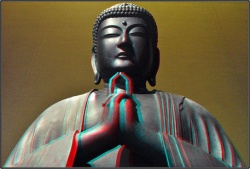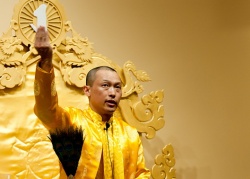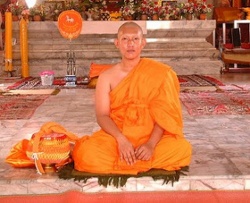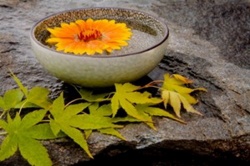Glossary of Terms (Zen)
AIGO (Korean): word for responding to an incomprehensible situation, such as sudden death, or grief, or even surprise.
Anuttara Samyak Sambodhi (Sanskrit): “perfect universal samadhi”; the enlightenment experience in which a person becomes a Buddha.
Avalokitesvara (Sanskrit): bodhisattva of compassion (see Kwan Seum Bosal).
beads: a string of beads resembling a bracelet or necklace, used for counting bows or repetitions of a mantra in various sects of Buddhism. Also known as a “mala.”
Bhikshu (Sanskrit): a fully ordained monk.
Bhikshuni (Sanskrit): a fully ordained nun.
Blue Cliff Record (Chinese: Pi-Ye-Lu; Japanese: Hekigan Roku): compiled in 1125 CE, one of the most important collections of kong-ans, still in use today.
bodhi (Sanskrit): “awakening”; enlightenment.
Bodhidharma (Sanskrit): the first Zen patriarch; he reputedly came to China in 520 CE. and sat for nine years facing a wall at Shao-Lin temple.
bodhisattva (Sanskrit): a being whose actions promote unity or harmony; one who vows to postpone one’s own enlightenment in order to help all sentient beings realize liberation; one who seeks enlightenment not only for oneself but for others. The bodhisattva ideal is at the heart of Mahayana and Zen Buddhism.
bodhisattva teacher: in the Kwan Um School of Zen, one who has met certain training requirements, usually over at least ten years, and has taken sixty-four precepts.
bosalnim (Korean): in Korea, a lay woman who helps at a temple
Buddha (Sanskrit): an awakened one; refers usually to Siddhartha Gautama (sixth century BCE), historic founder of Buddhism.
Buddha-nature: that which all sentient beings share and manifest through their particular form; according to Zen, the Buddha said that all things have Buddha-nature and therefore have the innate potential to become Buddha.
center: the vital energy center of the abdomen; in many Zen traditions it is considered to be the seat of the heart-body-mind. Focusing one’s attention on the hara is a technique used in some forms of Zen practice for centering and developing samadhi power.
ch’i (Chinese): life force.
Chogye order: the major order in Korean Buddhism, formed in 1356 by the unification of the Nine Mountains Schools of Zen.
Dae Soen Sa Nim (Korean): title used by Zen Master Seung Sahn’s students in referring to him; “great honored Zen Master.” In the Korea tradition, all Zen Masters are referred to as “Soen Sa Nim.” “Dae” (great) is added to their title when a teacher turns sixty.
dharani (Sanskrit): a long, mystical chant supposed to have innate power to induce various kinds of insights or magical powers.
dharma (Sanskrit): the way or law; the path; basically, Buddhist teaching, but in a wider sense any teaching or truth.
dharma room: in Zen Master Seung Sahn’s centers, the meditation/ceremony hall.
dharma teacher: in the Kwan Um School of Zen, one who has met certain training requirements, usually over at least four years, and has taken ten precepts.
DOL (Korean): shout to cut off discriminative thinking.
Dok Sahn, Duk Sahn (780-865 CE) (Korean; Chinese: Te-shan): one of the greatest Zen Masters in history; trained for forty years studying the Diamond Sutra, then was stumped by a simple question from a tea-vending woman and converted to Zen.
dukkha (Pali): suffering.
enlightenment: awakening.
five precepts: the first five lay vows of Buddhism:
I vow to abstain from taking life.
I vow to abstain from taking things not given.
I vow to abstain from lying.
I vow to abstain from misconduct done in lust.
I vow to abstain from intoxicants, taken to induce heedlessness.
great freedom: freedom from all conceptual understanding and bondage that comes in the wake of enlightenment.
great path: the path of liberation towards which a practitioner strives, or the path tread by a bodhisattva.
[[hapchang (Korean; Japanese: gassho): the gesture of placing the hands palm to palm before the chest to indicate respect, gratitude, and humility.
hara (Japanese): see center
HIT: the sound of a palm or stick hitting a table or floor; used to cut off discriminative thinking.
inka (Korean): “public seal;” certification of a student’s completion of, or breakthrough in, kong-an practice.
interview: a formal, private meeting between a Zen teacher and a student in which kong-ans are used to test and stimulate the student’s practice; may also occasion informal questions and instruction.
Ji Do Poep Sa Nim (JDPSN) (Korean): “dharma master”; a student who has been authorized to teach kong-an practice and lead retreats. The title is “Ji Do Poep Sa” for teachers who are monks or nuns.
Joju (778-897 CE) (Korean; Chinese: Chao Chou; Japanese: Joshu): his Chinese name is from the town in northern China where he lived and taught for the last forty years of his life; one of the most famous Zen Masters in history; prominent during the golden age of Zen in T’ang Dynasty China (618-907 CE).
kalpa (Sanskrit): an eon; the time period during which the physical universe is formed and destroyed. An unimaginably long period of time.
karma (Sanskrit): “cause and effect,” and the continuing process of action and reaction, accounting for the interpenetration of all phenomena. Thus our present thoughts, actions, and situations are the result of what we have done in the past, and our future thoughts, actions, and situations will be the product of what we are doing now. Individual karma results from this process.
kasa (Korean): brown piece of cloth worn around the neck or over the shoulders, symbolic of Buddhist vows and precepts.
KATZ! (Korean): traditional Zen belly shout; used to cut off discriminative thinking.
kensho (Japanese): seeing one’s own true nature; an experience of awakening.
Kido (Korean): “energy way”; a chanting retreat.
kimchee (Korean): spicy pickled cabbage.
kong-an (Korean; Japanese: koan): a paradoxical or irrational statement used by Zen teachers to cut through students’ thinking and bring them to realization.
Kwan Seum Bosal (Korean; Sanskrit: Avalokitesvara; Chinese: Kwan Yin; Korean: Kwan Um; Japanese: Kanzeon): “one who perceives the cries of the world” and responds with compassionate aid; the bodhisattva of compassion.
Kyol Che (Korean): “tight dharma”; in Korean Zen tradition, an intensive retreat of 21 to 90 days.
Lin Chi (d. 866 CE) (Chinese): Chinese Zen Master; founder of the Lin-chi (Rinzai) school of Zen, one of the two schools still active in Japan.
Mahakashyapa (Sanskrit): outstanding student of the Buddha. Buddha’s successor in leading the sangha.
Mahayana (Sanskrit) Buddhism: the Buddhism practiced in northern Asia; encompasses schools in China, Korea, Japan, and Tibet.
Ma Jo (709-788 CE) (Korean; Chinese: Ma-tsu): the great patriarch of Chinese Zen during the early T’ang period.
mala: see beads
mantra (Sanskrit): sounds or words used in meditation to cut through discriminating thoughts so the mind can become clear.
moktak (Korean): fish-shaped wooden instrument used as a drum to set the rhythm for chanting.
mu (Japanese): nothing, not, nothingness.
Mu Mun Kwan (Korean): “The Gateless Gate”; a collection of forty-eight traditional kong-an cases composed in 1228 by the monk Mu Mun Ekai (1184-1260); usually studied before the Blue Cliff Record.
nirvana (Sanskrit): a state of perfect inner stillness and peace; complete extinction of individual existence; cessation of rebirth; entry into bliss.
paramita (Sanskrit): virtues or “perfections” of a Buddha. In Mahayana Buddhism, these are the six paramitas: dana (generosity), sila (restraint or morality), shanti (patience), vigor (energy or effort), dhyana (meditation), prajna (wisdom).
patriarch: the founder of a school and his successors in the transmission of its teaching.
prajna (Sanskrit): wisdom.
roshi (Japanese): “venerable (spiritual) teacher”; a Zen Master.
samadhi (Sanskrit): a state of intense concentration.
samsara (Sanskrit): the cycle of birth, death, and rebirth.
sangha (Sanskrit): in the Mahayana and Zen traditions, the community of all practitioners; may refer to a family of students under a particular master.
sarira (Sanskrit): “body”; in Korean Buddhism, small crystals sometimes found among cremated remains of monks, and regarded as sacred relics.
satori (Japanese): the experience of awakening, enlightenment.
senior dharma teacher: in the Kwan Um School of Zen, one who has met certain training requirements, usually over at least nine years, and has taken sixteen precepts.
sesshin (Japanese): see Yong Maeng Jong Jin.
Shakyamuni Buddha (Sanskrit): “sage of the Shakya clan,” the historical Buddha.
shikantaza (Japanese): “just sitting”; a state of attention that is free from thoughts, directed to no object, and attached to no particular content.
skandhas (Sanskrit): the five aggregates which make up human existence: form, feelings, perceptions, impulses, consciousness.
Soen Sa Nim (Korean): “honored Zen teacher,” a Zen Master.
sutra (Sanskrit): Buddhist scriptures, consisting of discourses by the Buddha and his disciples.
Sunim (Korean): Honorific used in addressing or referring to a monk or nun.
ten directions: Buddhist cosmological concept; north, south, east, west, up, down, northwest, northeast, southeast, southwest.
Theravada (Sanskrit): the southern school of Buddhism, including Sri Lanka, Thailand and Burma.
TOK: the sound of the moktak.
transmission: formal handing over of the lineage succession from teacher to student. What one receives when one becomes a Zen Master
Un Mun (Korean; Chinese: Yun Men; Japanese: Ummon): Zen Master during the golden age of Zen in T’ang Dynasty China (618-907 CE).
Yong Maeng Jong Jin (Korean): literally, “valorous or intrepid concentration,” paraphrased “to leap like a tiger while sitting.” In the west it is a short silent retreat of two to seven days involving thirteen hours of formal meditation practice a day. Participants follow a schedule of bowing, sitting, chanting, eating, and working, with an emphasis on sitting meditation. During the retreat each participant has interviews with a Zen Master or Ji Do Poep Sa Nim.
zafu (Japanese): a round meditation cushion.
Zen (Japanese; Korean: Son; Chinese: Ch’an; Sanskrit: Dhyana): meditation practice.
Zen Center: meditation communities which may include a residence. All the Zen Centers in the Kwan Um School of Zen are under the spiritual direction of Zen Master Seung Sahn, and each offers regular practice and periodic retreats.
zendo (Japanese): “Zen hall;” dharma room, meditation hall.





